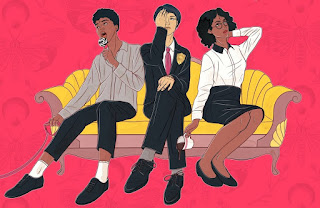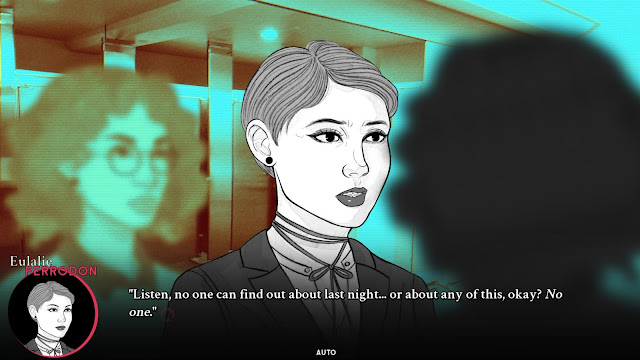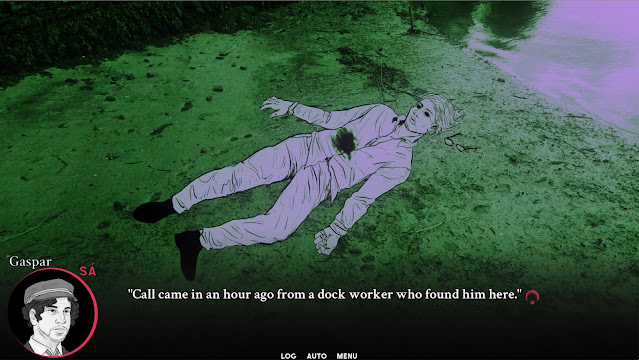Sometimes you put off playing a game that you regret the moment you start actually playing it. This has been my experience with Cross The Moon. I’ve had a copy sitting on my PC for over a year, but it was only because I had an excuse to review it on Switch that I started playing it at all. I’m so glad I did. This is going to be one of the great “hidden gems” of the future.
The game’s creator, Patrick Rainville, was kind enough to answer a bunch of my questions at great depth, so if you’ve ever wanted to get a sense of how indies work and build their games, this interview is one for you.
Matt S: What inspired Cross The Moon?
Patrick R: Cross the Moon was born from the ashes of ideas and projects that had run their course. The “cracked moon” imagery, as well as this alternate history Brittany, France, were born out of the final moments of a more gothic science fiction story I had been writing at the time (the remains of which would eventually become the events covered in Claire’s journal entries, found throughout CtM). I had a few visual novel collaborations that eventually fizzled out, though a takeaway from those was a strong desire to make something that eschewed the more traditional visual novel look.
As far as inspirations go, I’ll highlight a few. The novel Radiance by Catherynne M. Valente was a fantastic trip into this beautiful alternate history space odyssey that planted the seed for this story. Less so in the details and more in her expansive, infinitely playful storytelling that still managed to keep her characters grounded and loveable. I was jumping to write something the minute I finished reading it.
Stoker’s Dracula and Le Fanu’s Carmilla were perennial reads throughout CtM’s development. I find these books easy to return to, and treated them almost as “lore bibles” for my own worldbuilding. Something to return to whenever I felt lost weaving one of my overly convoluted story threads. I would gleam from them not so many answers, but ways forward in the dark.
Matt S: The most immediately obvious feature about this game is that aesthetic. How did you land on this being the art style for the game?
Patrick R: The game was made on a shoestring budget and I had decided early on that all of that money would go towards hiring an illustrator to design the characters. Using photographs for the backgrounds then became the only logical answer for me, though I had felt mixed on its implementation in many of the visual novels I had played.
A classic example being Higurashi When They Cry, which throws a sometimes nauseatingly blurry filter over top of lovely photographs of rural Japan. I didn’t want to do that. I understand that its intent is to better mesh the vibrant cartoony characters with the still life “plainness” of the photography, but in practice I just found it distracting in an unintentional way.
That was my jumping point, then. Maybe I could lean more into that foreground/background contrast by inverting the dynamic; making the characters fairly muted and consistent while allowing the backgrounds to run a bit wilder.
It was also important for me to have the characters feel like they were in the background, as opposed to the more typical visual novel presentation where the character portraits often appear ambiguously in the foreground; the background more a touchstone for the reader’s orientation. As a result, I tried as much as possible to have the placement and size of the character portraits be scaled and positioned proportionally to their changing environments. I gave my own stab at a “photoshop filter”, using photo editing software called Pixelmator, where I was essentially layering semi-transparent monochromatic versions of the photographs on top of each other, along with some subtle scanlines and film grain to bring it all together.
Similarly, I kept the game’s HUD minimalist in an attempt to have the reading experience be closer to say, reading subtitles in a movie, rather than densely packed textboxes.
I wanted someone to see a screenshot of Cross the Moon and not immediately guess it was a visual novel. Not because I don’t love visual novels, but because their visual design language is often very similar from one game to the next, so I thought it would be fun to make something that, if nothing else, had a look that would stand out.
Matt S: I found the allegory between vampirism and racism to be fascinating within Cross The Moon. What encouraged you to take that narrative direction?
Patrick R: Vampire stories have been used for centuries now to reflect back at us stories of the oppressed, the misunderstood. It seemed like a fairly natural fit, though I tried not to make too literal a connection, because compressing various forms of racism down to a vampire shaped mould could oversimplify deep systemic issues. I became aware while writing this story that too strong an emphasis on metaphorical racism might feel toothless or disingenuous if, say, my vampires were all white, or pre-existing forms of racism and inequality had magically vanished to make room for a one size fits all vampire narrative.
So I became more interested in exploring the fact that vampire culture, like any culture, wouldn’t be this one homogenous lived experience, but rather a cornucopia of intersectionality. The lives of the rich vampires are vastly different from those of the poor; a vampire belonging to a minority group likely wouldn’t have the same privileges or opportunities in a predominantly white, middle-class European city like L’Amour. The juxtaposition of Lux and Aurore’s parents – a white vampire man and a Black human woman – are an example of a tricky relationship dynamic I felt was important to approach thoughtfully.
Matt S: I also loved the noirish tones to the narrative. Was it a deliberate plan to provide players with a relatively straightforward crime fiction/thriller story set against such eccentric art?
Patrick R: Early on I had assumed I would just be running my photos through a high contrast black and white filter. The general beats of the murder mystery plotline were hashed out with that more gritty look in mind. By the time I was adding in colours, the story was finished. So in the end the juxtaposition of these two elements was more of a happy accident.
Patrick R: I am too married to the idea of my stories having an accompanying soundtrack to consider writing a proper novel. It would be too quiet.
And the level of organising, planning and overhead for making a movie – let alone filming one scene – would give me a panic attack. I am consistently amazed by the dedication, hard work and coordination of people on movie sets and all the planning that is involved. Not to mention post-production! No, no no, the visual novel medium is the right pace for me. The elegant authorial control of writing a book with the added safety net of images and sound whenever your words fail you. That’s the life for me. And even in a linear story like mine, being able to indefinitely pause on a line of dialogue as the music and atmosphere of the scene continue on is of utmost importance to me as a storyteller. I like giving the reader a chance to breathe, to define that pacing. Standing still and soaking in the atmosphere is one of my favourite aspects of many video games.
On the flip side, I think the lines between media are starting to blur. Visual novels with voice acting and more complex animation work, such as the recent Famicom Detective Club remakes, or Steins;Gate Elite, are bridging the gap between interactive fiction, motion comics and anime.
Matt S: As someone working on VNs myself – though not to the standard of yours by any means – I’m always interested in hearing how others have gone about it. What is it about the process that you’ve found most interesting, challenging, and rewarding?
Patrick R: That nonexistent barrier to entry for installing and learning Ren’Py was without a doubt the thing that got my foot in the door. I’m still blown away by how much you can do right out of the box, with just the help of the built-in tutorial and documentation. Beyond that, the thing that makes Ren’Py sing (and any successful game engine) is its online community. All the challenges I came up against while programming Cross the Moon were solved not by myself alone but by the helpful people on the Lemma Soft Forums. From incorporating a more dynamic music mixer that let gave me more granular control over the music layers, to how to best create the sensation of movement within a car, to integrating Steam Achievements, the community had my back!
Recently I’ve started learning Unity and its Naninovel plugin for my next project, and again, the community and developer support has been astounding. I can’t understate how crucial that support has been.
Matt S: What was the experience like porting the games to console? I know this originally released on PC, but I found it much easier to pick up because I prefer VNs on console. Are you finding new audiences for the game now?
Patrick R: Your sentiment about playing visual novels on Switch is one I share.
The porting process was relatively hands-off. I had submitted a copy of my game to Ratalaika and they showed interest in porting it to consoles. Easy! I’m very grateful and fortunate they agreed to this because it has certainly given Cross the Moon a second life. When the game came out on PC last year, it sold to friends and family but that was it. Also, I’m sure it didn’t help that it came out the week COVID-19 was upgraded to the status of Global Pandemic…
So yes, the console release has given it a new audience. A small one, certainly, but it has exceeded my expectations. My personal goal for Cross the Moon was for it to reach and resonate with at least a few strangers, and the console version has made that possible.
Matt S: Are we going to see more visual novels from you in the future?
Patrick R: Absolutely! Though as a stay-at-home dad with an adventurous toddler, my game development time has shrunken considerably. During my daughter’s nap time, if I’m not taking one myself, I’ve started learning Naninovel (a plugin for the Unity game engine specifically made for making visual novels) and that’s been consuming a lot of my creative time. I’ve decided to move away from Ren’Py (at least for now) because I like some of the possibilities of a more exhaustive engine like Unity; I would love to make a visual novel rhythm game, or a hybrid 2D portrait/3D backgrounds visual novel like the Danganronpa series.
My mind is racing with more ideas than time, though I would like my next project to be much smaller in scope than Cross the Moon, with only a handful of locations and characters…
Matt S: You’ve got a background in music. I assume the soundtrack in Cross The Moon is yours? What was scoring a visual novel like as an experience?
Patrick R: Scoring Cross the Moon was done near the very end of the project over the span of one month. I didn’t budget much time for it since it was the one aspect of game development I had experience in (my partner was five months pregnant at the time and I was hoping to finish the game before our daughter was born – I failed). I wish I had given myself more time since scoring is also my favourite part of game development. As someone who mostly does freelance composition work for short film and television, I always wanted to make my own games so I could call all the shots regarding the music.
I implemented a five-track mixer in Cross the Moon, which allowed me to have multiple versions of piece of music fade in and out based on key moments in the story seamlessly. This was especially useful near the end of the story, where the three storylines begin to converge and the cuts between scenes become more frequent, thus allowing the music to dynamically match what’s happening on screen.
Matt S: Finally, when you’re not making games, what do you enjoy playing?
Patrick R: I am currently playing the FMV train game Japanese Rail Sim: Journey to Kyoto on PS5 and that might just be my current GOTY frontrunner! It looks like they strapped a mid-2000s GoPro on the front of a real train and then made a game around that footage. Player involvement is fairly minimal: you control the acceleration and breaks of the train, though really all you are doing is manipulating the playback speed of the video… but it is a gorgeous, meditative experience full of tiny details of the everyday lives of Japanese commuters and the vibrant neighbourhoods you cross.
I am a massive Final Fantasy fan, and am very much looking forward to the pixel remasters of the original six games coming this year. I’m also in the middle of another replay of Final Fantasy VII Remake. I don’t think I’ll ever grow tired of that game.
Beyond that, my favourite genres are visual novels(!) and rhythm games. I am currently waiting for my physical copy of The House in Fata Morgana for Switch to come in so I can finally dive in…
– Matt S.
Editor-in-Chief
Find me on Twitter: @mattsainsb












